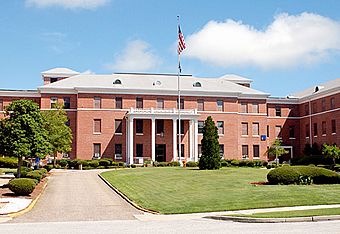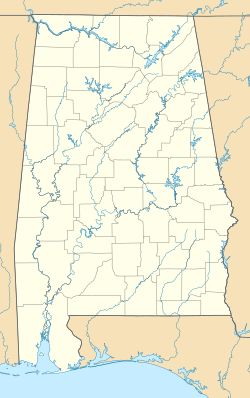Tuskegee Veterans Administration Medical Center facts for kids
Quick facts for kids |
|
|
Tuskegee Veterans Administration Hospital
|
|
 |
|
| Location | Tuskegee, Alabama |
|---|---|
| Built | 1923 |
| NRHP reference No. | 12000140 |
| Added to NRHP | March 19, 2012 |
The Tuskegee Veterans Administration Medical Center began in 1923. It was a special hospital for soldiers in Tuskegee, Alabama. At first, it was called the Tuskegee Home. It was part of a larger system for disabled volunteer soldiers.
This hospital complex grew to have 27 buildings. It was built next to the Tuskegee Institute campus. This is now Tuskegee University. The university even gave 300 acres of land for the hospital.
Its main purpose was to care for African-American soldiers from World War I. Many of these soldiers lived in the segregated South. Other hospitals often did not give them proper care. After the war, the government faced challenges. They needed to help veterans find jobs. They also needed to care for those who were hurt or sick. Veterans had served their country. They wanted the government to help them get back to normal life.
In 1930, three government groups combined. They formed the Veterans Administration. The Tuskegee hospital then became part of this new agency. Since 1997, the hospital has been part of a bigger system. It is now called the East Campus of the Central Alabama Veterans Health Care System. This system has four locations in Alabama and Georgia.
Contents
A Special Hospital for Veterans
The Tuskegee hospital was created to help African-American soldiers from World War I. These veterans often had trouble getting care at other hospitals. This was especially true in the segregated Southern states. Groups like the NAACP worked hard. They pushed the government to care for these veterans. They wanted health care, jobs, and training.
Early plans for the hospital were to have only white doctors and nurses. They even planned for white nurses to have "colored nurse-maids." This was to keep them from touching Black patients.
The hospital planned to treat tuberculosis and mental health issues. These included "shell shock," now called post-traumatic stress disorder. These were common problems for soldiers after the war. White people in Tuskegee wanted to control the jobs at the new hospital. They wanted these jobs for themselves.
Fighting for Equal Job Opportunities
At the same time, African Americans wanted professional jobs at the hospital. Dr. Robert Russa Moton was the president of Tuskegee Institute. He had to be very careful. He wanted to keep good relations with white people in the city. But he also faced pressure from the NAACP. The National Medical Association (a group of Black doctors) also pushed him. They wanted to make sure Black doctors and nurses got jobs. These professionals had limited job chances, especially in Alabama.
Dr. Moton, the NAACP, and the NMA spoke to President Warren G. Harding. They told him his political party would lose Black support. Many Black people had fought in the war. They needed jobs at this hospital. President Harding then told officials to hire Black doctors and nurses. He promised these jobs would be for Black professionals.
White people in Tuskegee strongly opposed this. Dr. Moton even received threats. A local group of the Ku Klux Klan marched on the hospital. But this led to a bigger effort by the NAACP and NMA. Their fight gained national attention. Other white people in the South did not support the Tuskegee whites.
By 1924, things calmed down. Brig. Gen. Frank T. Hines was the head of the Veterans Bureau. He appointed Dr. Joseph H. Ward, an African American, to lead the hospital. For the next ten years, about half of all Black veterans needing hospital care went to Tuskegee. All the Black doctors working for the Veterans Bureau worked there too. This period helped ensure Black veterans got good care. It also helped African Americans get professional jobs in health care.
Hospital Growth and Leadership
The hospital opened with 600 beds and 250 patients. The first medical officer in charge was a white man, Colonel Robert H. Stanley. But within a year, the government appointed African-American leaders. Many doctors were also Black. In 1930, the hospital became part of the United States Veterans Administration system.
By 1973, the hospital had 2307 beds. This included a 120-bed nursing home.
Dr. Toussaint T. Tildon was a psychiatrist. He graduated from Harvard Medical School. He was one of the first six African-American doctors hired at the new hospital. He worked there for 34 years. From 1946 to 1958, he was the director. Starting in the 1940s, he worked to get full approval for training programs at the hospital. These programs were for doctors and dentists. He worked with the University of Alabama and Emory University. He also made sure Black doctors could get good federal jobs. Many more training programs were added over the years.
In 1997, the Tuskegee center joined with a VA center in Montgomery, Alabama. It also joined with clinics in Dothan, Alabama and Columbus, Georgia. Together, they formed the Central Alabama Veterans Health Care System (CAVHCS). The Tuskegee hospital is now called the East Campus of CAVHCS. These four locations serve 134,000 veterans. They cover 43 counties in Alabama and Georgia.
Today, more care is given to patients who don't stay overnight. The center has 143 hospital beds. It also has 160 nursing home beds and 43 beds for homeless veterans.
In 2012, the Tuskegee complex was added to the National Register of Historic Places. This means it is a special historic site.
Hospital Directors
- Dr. Charles W. Griffith, 1923–24
- Dr. Joseph H. Ward, 1924–36
- Dr. Eugene Dibble, 1936–46
- Dr. Toussaint T. Tildon, 1946–58
- Dr. Prince P. Barker, 1958–59
- Dr. Howard W. Kenney, 1959–62
- Dr. Julian W. Giles, 1962–69
- Dr. Robert S. Wilson, 1969–72
- Lucian A. Green, 1972-197?
- Dr. David A. Tull, 1976–86
- 1997, the hospital merged into the Central Alabama Veterans Health Care System (CAVHCS). Tuskegee became the East Campus.
- Shirley Bealer, Acting Director, CAVHCS, 2008
- Linda Boyle, 2016-2019
- Amir Farooqi,(Interim Director) 2019–present



